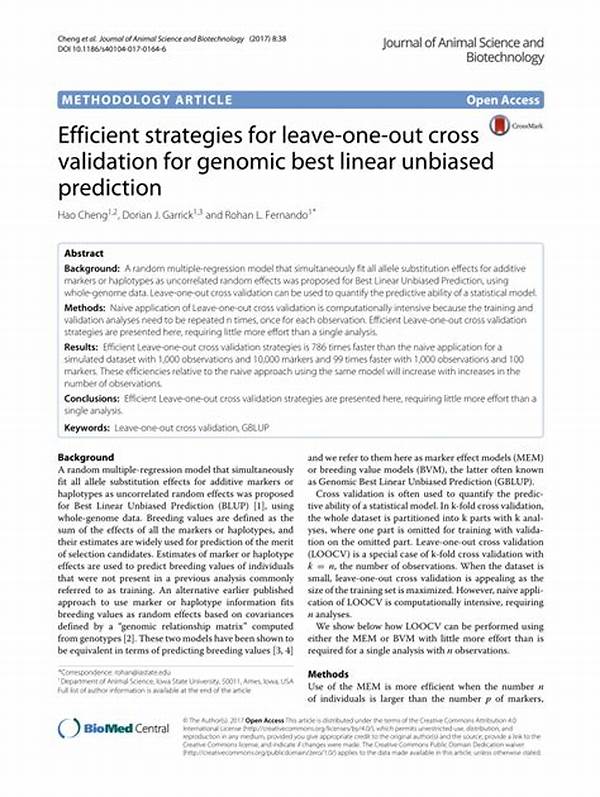In the constantly evolving field of machine learning, having the right tools can significantly transform challenges into opportunities. Efficient cross-validation strategies stand out as key players in this dynamic environment, enhancing predictive accuracy and model reliability while ensuring optimal resource use. Imagine a scenario of constructing a high-rise building. Would you proceed without a solid foundation? Certainly not. This analogy holds in machine learning, where cross-validation serves as the foundation for model evaluation and selection, providing a robust check against overfitting and underfitting, ensuring your model performs well on unseen data.
In today’s data-driven world, businesses that harness the power of efficient cross-validation strategies can gain a substantial competitive edge. Remember battling with a Rubik’s cube? At first glance, it seems impossible. But with the proper strategy, the jumble unwinds into perfect symmetry. Similarly, the chaos of big data can be synergized with the clarity of cross-validation. This article explores efficient cross-validation strategies, delving into methods that not only ensure balanced validation but also foster strategic resource allocation.
From students to seasoned data scientists, everyone can reap benefits by embedding efficient cross-validation strategies into their analytical routine. It’s not merely about splitting data into training and testing sets; it’s about smart planning, ensuring minimal bias and variance. The magic of cross-validation lies in its dynamic approach, reflecting real-world data scenarios to the machine learning algorithms, making them more adaptable and precise.
Join us on this enlightening ride where methods like k-fold, stratified sampling, and time-series validation are unraveled, offering a seamless blend of theory with pragmatic insights. Let the stories and anecdotes enhance your understanding while the statistics ground you in reality. The journey promises to be as captivating as a thrilling novel, with efficient cross-validation strategies playing the hero saving the day.
Exploring Key Cross-Validation Methods
To successfully implement efficient cross-validation strategies, one must understand the key methodologies that drive accuracy and efficiency. Adopting approaches such as k-fold cross-validation allows for the assessment of model performance across varying datasets, reducing overfit risks. Through these validations, patterns emerge that can lead to better model optimization.
—
Structured Outline of Efficient Cross-Validation Strategies
Efficient cross-validation strategies are pivotal to the success of predictive modeling in machine learning, acting as a guardian against inaccurate generalizations.
Efficient cross-validation strategies begin with understanding the data’s nature. For instance, does your dataset require time-sensitive validation? In such cases, time-series cross-validation can be invaluable. Transforming data hurdles into smooth pavements, these strategies bolster model performance through informed decisions, making predictions more reliable.
Incorporating cross-validation techniques like leave-one-out ensures nearly unbiased performance scoring. Though computationally expensive, the insights gathered can drive significant improvements. Imagine a painter outlining every detail with precision, ensuring his art tells the intended story—that’s what well-structured validation achieves for machine learning models.
Moreover, efficient cross-validation strategies aren’t confined to academia. They’re indispensable tools in industries like finance, healthcare, and marketing, where even minor improvements in predictive accuracy can lead to substantial real-world impacts. They aren’t just a necessity; they are the game-changers of the data analysis world.
Why Businesses Must Prioritize Cross-Validation
Understanding efficient cross-validation strategies is crucial for businesses looking to optimize decision-making processes. These strategies safeguard models from overfitting, permitting them to maintain predictions that closely mimic reality, thereby enhancing business intelligence processes.
Types of Cross-Validation
Diving into the different types of cross-validation helps in identifying which strategy aligns best with your data needs. Distinguishing between k-fold, leave-one-out, and stratified cross-validation techniques lays the foundation for strategic decision-making, maximizing efficiency while preserving computational resources.
—
Key Takeaways on Efficient Cross-Validation Strategies
Explore the essential points related to efficient cross-validation strategies and how they affect analytics:
—
Delving into the Importance of Cross-Validation
Cross-validation in machine learning is akin to a conductor guiding a symphony. Without it, orchestration of various data points would be chaotic and dissonant. Efficient cross-validation strategies ensure that each element in the data ensemble complements others, enhancing the overall performance of predictive models.
Efficient cross-validation strategies stand as a beacon of hope for data scientists trying to extract meaningful insights from oceans of data. Consider them the specialized tools in a kit, indispensable for precise tuning and alignment of data-driven projects. With these strategies, what was once a tangled mess of numbers and variables becomes a coherent, compelling narrative.
In a bustling startup environment, where every decision can pivot the company’s future, efficient cross-validation strategies act as a liability shield, saving engineers from going awry. Testimonials from industry giants reveal that these strategies have saved substantial resources and enhanced accuracy by revealing hidden data patterns, providing crucial foresight in planning stages.
Just picture a dedicated team working tirelessly, each member relying on efficient cross-validation strategies to ensure the data models they build can stand any test thrown their way. Whether in manufacturing or tech, these strategies are universally applicable, guiding the path toward data-driven success, unleashing data’s true potential.
Applying Efficient Cross-Validation Strategies in Practice
Understanding is the first step; applying efficient cross-validation strategies is where tangible value is realized. Through practical implementation, theories morph into reality, making them invaluable companions in any predictive analytics journey. This involves not just learning the strategies but being adept at analyzing their outcomes.
While academic insights into cross-validation are profound, the application speaks volumes about its power. Envision a chef blending the finest ingredients to create a culinary masterpiece—this is analogous to data scientists applying efficient cross-validation strategies, ensuring no stone is left unturned in pursuit of perfection.
Galvanizing Analytics with Cross-Validation
The transformative power of efficient cross-validation in data refinement is unmatched. By leveraging these insights, models become not merely tools but strategic assets driving success narratives for businesses globally.

